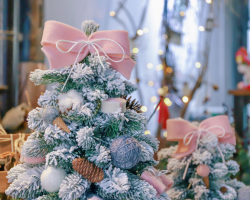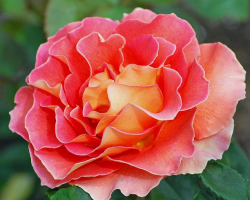Beauty, which from the first spring warm to cloudy November days will delight the eye - who does not want his flowerbed to be just like that! At the same time, in order for color harmony to be present, a smooth transition from flowering of some plants to others, so that the plants are peacefully adjacent and do not supplant each other.
Content
- What is a flower bed of continuous flowering?
- What basic rules are formed by a flower bed of continuous flowering?
- How to create a flower bed with many years of continuous flowering colors?
- How to choose a color scheme for flower beds from perennials of continuous flowering?
- How to choose flowers for flower beds from perennials of continuous flowering?
- When and how to plant flowers for flower beds from perennials of continuous flowering?
- How to care for a flower bed from perennials of continuous flowering?
- How to draw up a scheme of flower beds from perennials of continuous flowering: Examples
- Club from perennials of continuous flowering: tips
- Video: a scheme of a flowerbed, which will always delight with its flowering
All these and other requirements are fully fulfilled if you equip a continuous flowering flower on your site.
What is a flower bed of continuous flowering?
- A flowering flowering flowering is called flower garden, for which plants are selected at once in several parameters: height, color, shape of the leaves, growth rate, etc..
- At the same time, the main indicator for the selection is the flowering time of the plant: it is important that flowering specimens are constantly present on the flowerbed. Those who have already faded, like those in the period of growth, act as a background component.
- Flower of continuous flowering can also be rightfully defined as mixborder. The word “mix” itself indicates that mixing is happening: flowers and shades, tall and stunted, perennials and annuals. And if you use evergreen and coniferous plantings in the design of such a flowerbed, then it will delight the eye in winter.

What basic rules are formed by a flower bed of continuous flowering?
- The first and most necessary rule - the size of the flower bed of continuous flowering should be large, since in order for it to be a blooming oasis for a long time, it is necessary to plant many types of colors.
- The second rule is the predominant use of exactly perennial specimens, They are easier to care and bloom regardless of when sown and when the seedlings are planted on a flowerbed.
- The third moment is the choice of unpretentious colors. This is due to the fact that each plant has its own requirements regarding the soil, frequency and abundance of irrigation, lighting and other factors. Having planted quite capricious plants nearby, it will be difficult to achieve comfort for each of them.
- The fourth rule is to adhere natural style during free landing. It is better to plant flowers not in solitary order, but in the group, otherwise you will get a motley mishmash, in which it will be difficult to consider each species. The exception may be large bush specimens, for example, a tree -like peony.
- Fifth rule: choose for planting on a flowerbed plants whose foliage does not dry out and does not become terrible after the color ends. So you will provide a bright green background for a long time, otherwise your flower bed will look sloppy. A great example is the flowers of Arabis, which, stopping the color already in May, can remain a colorful green and white curb until autumn days.
- And, finally, the sixth rule: annually “restore order” on the flowerbed of continuous flowering, removing copies that have already lost their decorativeness, replacing them with new ones.

How to create a flower bed with many years of continuous flowering colors?
- Carry out work on landing perennial plants, breaking the flower bed of continuous flowering, it is necessary in the fall - So the plants take root and bloom in a few months, with the onset of spring. At the same time, bulbous plants are planted, which winter in the ground, for example, daffodils with crocuses, tulips with halantus, hyacinths and scillers.
- If you are already growing perennials, you have decided how they adapt to the conditions, and with the sequence of their flowering. So you can form the basis of the ever -flowering flower beds, and if there are times in your flower beds when flowering is not observed, acquire flowers that bloom in these periods so that they fill these “gaps”.
- Can be planted on such an eternally flowering flowerbed the same specimens with an early and late flowering period, especially if you like this or that flower - so you will extend the pleasure of admiring them. For example, from the beginning of May, your eyes will delight the irises of the dwarf varieties, and at the beginning of summer - tall handsome men.
- You can supplement the flower flower bed with annuals that have a long flowering period: salvia, verbena, marigolds, petunias etc. They will perform two functions at once: they will become an excellent bright accent until the time that perennial plants bloom, and “cover” those places where the plants were damaged by pests or unsuccessful wintering.

How to choose a color scheme for flower beds from perennials of continuous flowering?
- This is a rather difficult task, because changes in the color scheme on an eternally flowering flower bed occur more than once during the season. In the spring, when the primroses bloom, shades and paints are replaced quickly, just as the first spring flowers bloom. Here the combination of white and blue will be appropriate when they appear crocuses and snowdrops, they are replaced by daffodils and primrose that color the flowerbed with all the colors of the rainbow. Then-the queue of tulips, which also have the most diverse color, and will complement their white arabis, yellow Doronikum and blue-blue shades stepproof and muscari.
- The same bright palette is represented and irises, the most popular colors of which are lilac, blue, yellow-brown. Then peonies bloom along with lilyniki and dolphinium. They will perfectly shade perennial cloves with a small height. The phloxes and astilbe, which will replace, can be selected not only depending on the shade, but also to take into account their height and flowering time, supplementing the pink echinacea or the white Nivyanik.
- Concerning roses, their flowering time is from the first summer days before the onset of autumn colds. Their color and varieties are so diverse that, having selected specimens blooming in early times, you can equip a flower bed of continuous flowering from the roses.
- Autumn flowering - time chrysanthemum, dahlia, marigolds, calendula, salvia. Most often they create a yellow-red gamut. And, of course, in anticipation of the growth of perennial plants, it will not hurt to supplement the flower bed with annuals, for example, petunias that can delight the eye with their color throughout the summer.
How to choose flowers for flower beds from perennials of continuous flowering?
When selecting plants, it is important to consider several parameters:
- Flowering time;
- Coloring of specimens;
- Flower height;
- Similar conditions for growing.

- If with the first three points everything is clear enough - picking up flowers for a continuous flowering flower, so that some bloom, while others bloom at that time, plant them so that low -growing specimens are not closed with high plants, and in color scheme - it all depends From your preferences, then the conditions of content and compatibility should be said separately.
- Flowers must be selected so that all of them feel good in similar conditions. That is, they should have approximately similar requirements regarding the frequency of irrigation, soil composition and its moisture, as well as to illumination. For example, if you drop out nearby snowdrops or hostwho prefer a shadow, and a verbena with poppy seeds that need as many sun as possible, then some copies will be uncomfortable. Requireing frequent watering irises and not loving excessive moisture of echinacea is also unlikely to get along in the same conditions. And oregano will grow on poor soils, but the rhododendron will disappear.
- In addition, take into account that lily of the valleyFor example, due to a fast -growing root system, a self -sowing can grow throughout the flowerbed, and the bell is characterized by self -sides, which can also lead to its growth in those places that you planned for completely other colors. The sunflower depleys the soil, taking nutrients from it, which is detrimental to its neighbors.

When and how to plant flowers for flower beds from perennials of continuous flowering?
- Perennials are best planted with the beginning of autumn so that they can take root, winter and start flowering since spring. They also do onion plants.
- And so that before the start of their flowering, the flowerbed of continuous flowering is not empty, since February you can plant the seedlings of annuals and when the heat becomes stable, transplant them to a flowerbed, where they will create bright color spots. If you land them in a warm spring time directly into the soil, then they will begin to bloom later.
- When planting perennials, leave them the space up to half a meter so that they can grow. The same should be done with annuals. A peculiar “stock” of annual plants in a separate place does not hurt to make in a separate place: if you see that somewhere a void is formed, you can fill it with these specimens.
- It is better to start planting annuals with the central part of the flowerbed, and if you plant not in a circle, then then.
How to care for a flower bed from perennials of continuous flowering?
- Flowers need top dressing. Since there are many species, it is better to use universal compositions that are introduced in the warm season in a small amount of 3-4 times.
- When the flower has faded, immediately remove it, because it is possible to samosev, which will spoil your flower bed in the next season. In addition, wilted flowers, like the leaves, will make a flower bed of continuous flowering ugly and sloppy. At the same time, if the grimy leaves are practically not visible because of the growing colors, they can not be cut off-the appearance of the flower garden will not suffer, and the soil will receive additional organic fertilizer.
- Pay special attention onion plants. Usually they winter in the ground without the need for digging. The exception is particularly sensitive, not adapted to frosts that are better to dig.
- Also, at the end of flowering, when the stem dries, you can dig those plants that have grown too much. The bulbs should be carefully separated from each other, dried and stored until the autumn period, when they can be planted in open ground.
How to draw up a scheme of flower beds from perennials of continuous flowering: Examples
- A pre -compiled schematic picture of the future flower bed of continuous flowering will help to better imagine, what will the combination of colors look like, how many specimens of plants will be needed, which ones. You can sketch several schemes to clearly see the advantages of a particular option, its applicability in the conditions of the area you highlighted.
- The scheme can be drawn on a large sheet drawn on the cells, taking a scale for each of the cells: depending on the total area of \u200b\u200byour flower garden, you can consider one cage as a quarter or half a meter. Now fill the cells by looking for an optimal place for plants that you plan to plant: so you can see who is adjacent to whom, whether the flowers are replaced by flowering time, whether they are combined in height and color scheme. On such a scheme, one can also provide a diameter that a bush planting of a particular plant will achieve in 3-4 years.
- The basic rules for filling out a flower bed with perennials are already described above. Adhering to them, you can make a flowerbed according to a scheme that will make it possible to admire continuous flowering, starting from March-April, and ending with November days.

Example 1:
A universal composition, which combines specimens blooming at different times. They are marked by the following positions:
- snowy force;
- lungwort;
- delphinium;
- grassy sunflower;
- miscantus Chinese;
- blizzard phlox;
- daffodils;
- glenium;
- hellebore;
- astral;
- coreopsis of mutual;
- hare cabbage;
- geranium;
- aquilegia;
- kotovnik;
- sage;
- astra cushionate;
- persian bell;
- remote flower flowerpot with seasonal plants;
- geranium;
- the cuff is soft.


Example 2:
Another option for a flowerbed of perennial plants, which can be broken both in the shade and in a well -lit place. Such a flowerbed is arranged according to the principle of year-round combination of yellow, red and blue-blue shades:
- rosa roses (shades can be any);
- the sunflower is ten -seal;
- icelandic poppy;
- st. John's wort;
- cardinal lobelia;
- kotovnik Fassen;
- knohari bell;
- katananhe is blue;
- gravilate Chilean Feuerball;
- matrona cleaning;
- heihera is blood red.

Example 3:
This scheme shows an autumn flower garden in which they are adjacent:
- Thuja western "Yellow ribbon";
- Echinacea of \u200b\u200bthree types: “Mama Mia”, “Marmalade” and “Tangerine Dream”;
- Japanese spirea "Golden Carpet";
- Little Bunny Penissetum;
- Sedum "Black Beauty" (the name more known in our country is the cleansing);
- Lime Glow juniper;
- Pennisetum bristly "Rubrum";
- Proso Prothevoid "Rotstrahlbusch".

Example 4:
And here is an example of a scheme for a flower bed in the spring-summer period, designed according to all the rules of placement in the height of plants:
- general -root geranium;
- cleaning;
- iris Siberian;
- yarrow gold;
- the peony bush "Rubra Plena";
- bush of millet -shaped millet "Heavy metal";
- the bush of the ordinary muzzle.

Example 5:
But the original decorative solution: the color scheme of the planted plants creates the illusion of a flowing stream:
- bamboo leaflet (as an option for replacing you can choose an ostrich);
- irises;
- lobelia;
- creeping tenacity;
- knohari bell;
- hybrids output;
- brunner is large -leaved;
- shilolite Mshanka;
- red creeping living;
- and again, a bamboo leaf-column or ostrich, they will “closed” the composition into a single whole.

Club from perennials of continuous flowering: tips
- To choose plants that will feel comfortable in the climatic conditions of your region, pay attention to what flowers, shrubs, herbs are planted in flower beds in parks and squares of your settlement. This choice was held by professional landscapers, taking into account plant requirements.
- If you liked the color scheme, you can duplicate it. For example, you planted a frost, whose snow -white flowers look great next to blue crocuses. Feel free to plant anemones and muscars nearby, which will bloom later, while preserving the combination of white and blue.
- Plants with variegated leaves will look beautiful both in the group and in the form of a border strip. The same unpretentious cooles will save you from caring and please the whole season with an elegant look.
- The continuity of flowering your flower bed can be provided even in winter. To do this, you can supplement the flower garden with coniferous specimens, which will make the site green and elegant and in the winter months.
Useful articles on the site:
- Perennial flowers of dahlias - tubers planting, growing
- DIY flower beds and flower beds from improvised means
- How to feed home plants correctly
- The best perennial flowers for your garden
- Blue flowers for the garden







